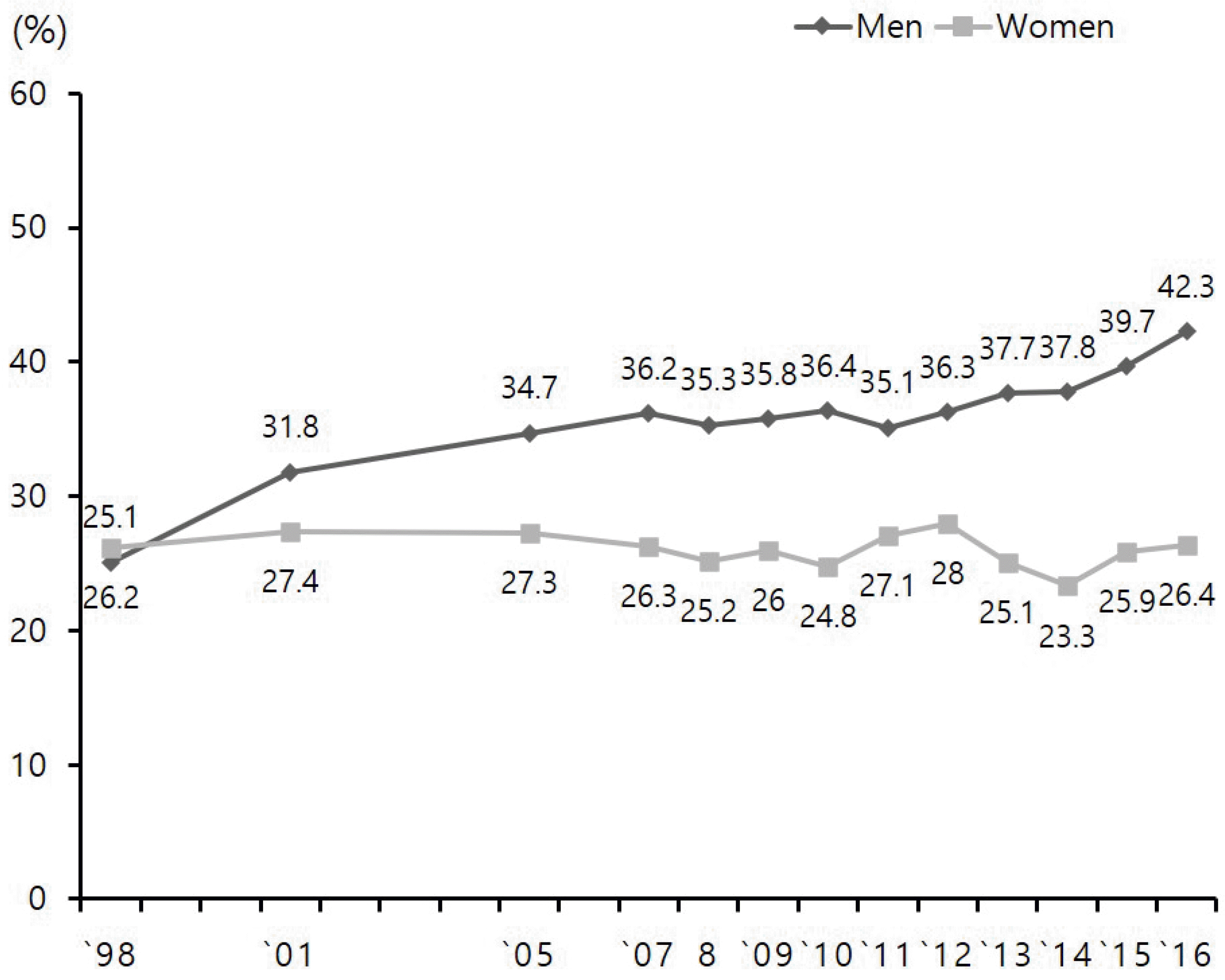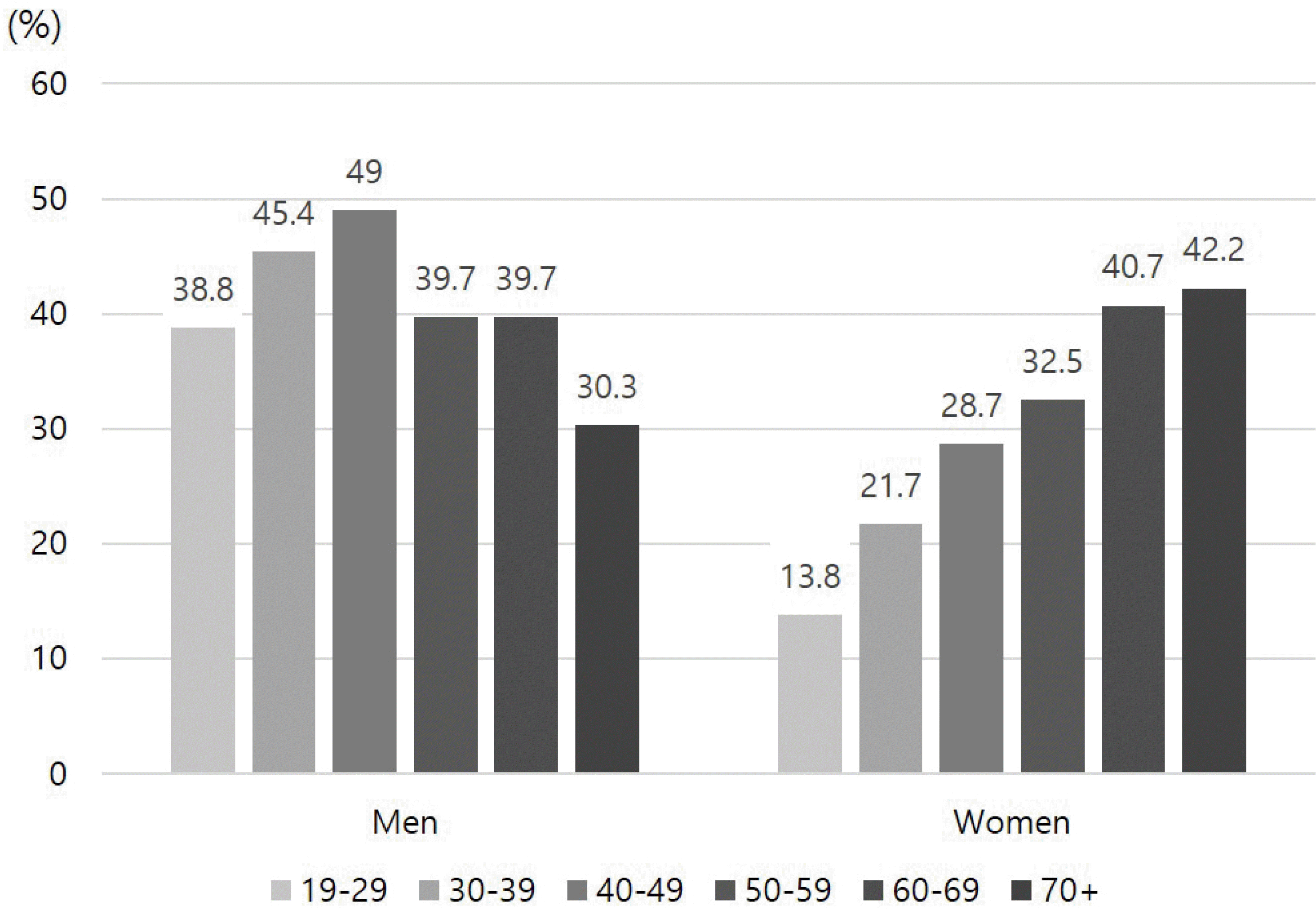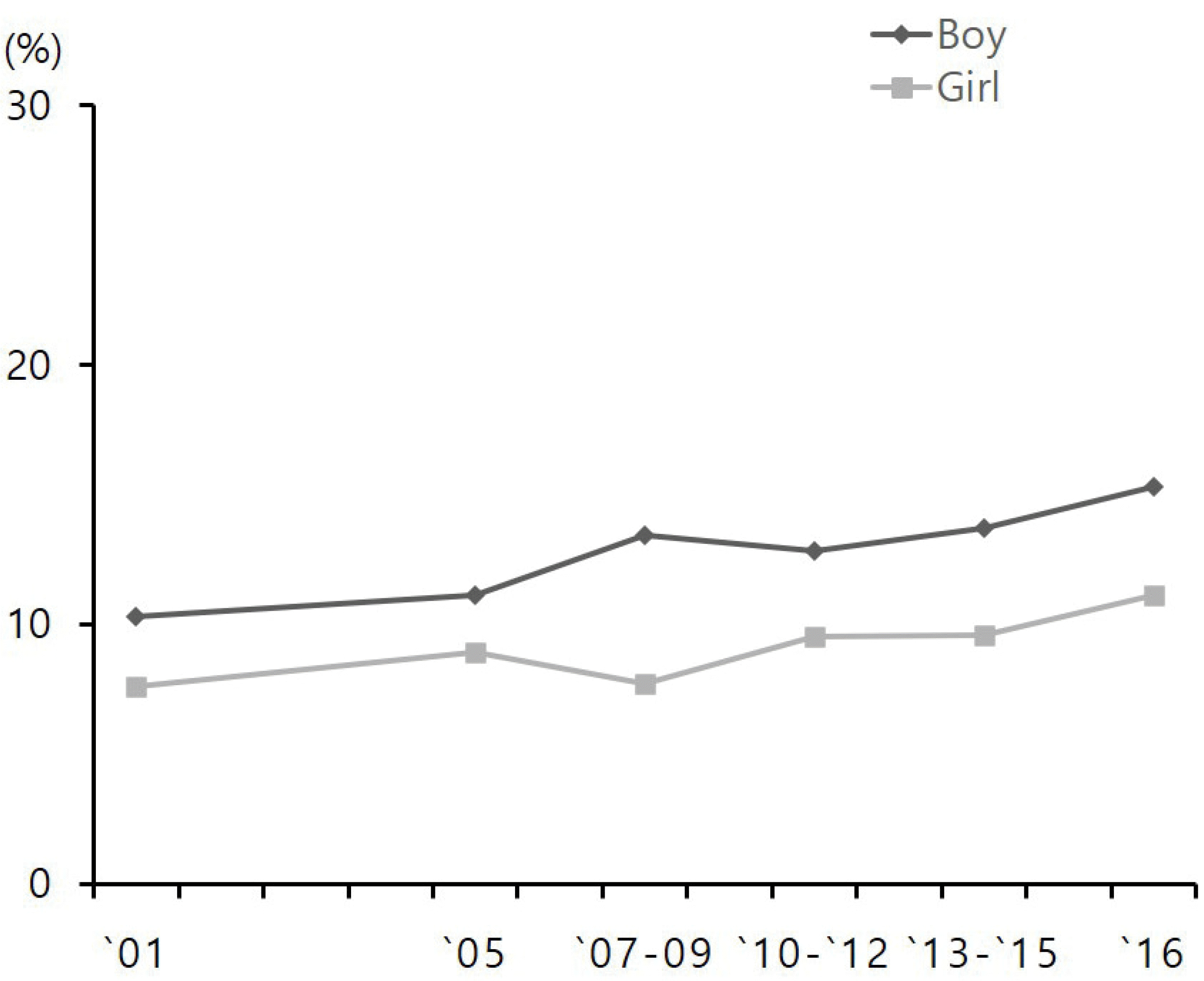2. Ng M, Fleming T, Robinson M, et al. 2014; Global, regional, and national prevalence of overweight and obesity in children and adults during 1980-2013: a systematic analysis for the Global Burden of Disease Study 2013. Lancet. 384:766–781. DOI:
10.1016/S0140-6736(14)60460-8. PMID:
24880830. PMCID:
PMC4624264.
4. Krishna SG, Hinton A, Oza V, et al. 2015; Morbid obesity is associated with adverse clinical outcomes in acute pancreatitis: a propensity-matched study. Am J Gastroenterol. 110:1608–1619. DOI:
10.1038/ajg.2015.343. PMID:
26482857.

5. Cruz-Monserrate Z, Conwell DL, Krishna SG. 2016; The impact of obesity on gallstone disease, acute pancreatitis, and pancreatic cancer. Gastroenterol Clin North Am. 45:625–637. DOI:
10.1016/j.gtc.2016.07.010. PMID:
27837777.

6. Dittrick GW, Thompson JS, Campos D, Bremers D, Sudan D. 2005; Gallbladder pathology in morbid obesity. Obes Surg. 15:238–242. DOI:
10.1381/0960892053268273. PMID:
15802067.

7. Stender S, Nordestgaard BG, Tybjaerg-Hansen A. 2013; Elevated body mass index as a causal risk factor for symptomatic gallstone disease: a Mendelian randomization study. Hepatology. 58:2133–2141. DOI:
10.1002/hep.26563. PMID:
23775818.

8. Stampfer MJ, Maclure KM, Colditz GA, Manson JE, Willett WC. 1992; Risk of symptomatic gallstones in women with severe obesity. Am J Clin Nutr. 55:652–658. DOI:
10.1093/ajcn/55.3.652. PMID:
1550039.

9. Tsai CJ, Leitzmann MF, Willett WC, Giovannucci EL. 2004; Prospective study of abdominal adiposity and gallstone disease in US men. Am J Clin Nutr. 80:38–44. DOI:
10.1093/ajcn/80.1.38. PMID:
15213025.

10. Freeman JB, Meyer PD, Printen KJ, Mason EE, DenBesten L. 1975; Analysis of gallbladder bile in morbid obesity. Am J Surg. 129:163–166. DOI:
10.1016/0002-9610(75)90292-5.

11. Maclure KM, Hayes KC, Colditz GA, Stampfer MJ, Speizer FE, Willett WC. 1989; Weight, diet, and the risk of symptomatic gallstones in middle-aged women. N Engl J Med. 321:563–569. DOI:
10.1056/NEJM198908313210902. PMID:
2761600.

12. Portincasa P, Di Ciaula A, Palmieri V, Van Berge-Henegouwen GP, Palasciano G. 1995; Effects of cholestyramine on gallbladder and gastric emptying in obese and lean subjects. Eur J Clin Invest. 25:746–753. DOI:
10.1111/j.1365-2362.1995.tb01953.x. PMID:
8557061.

13. Bonfrate L, Wang DQ, Garruti G, Portincasa P. 2014; Obesity and the risk and prognosis of gallstone disease and pancreatitis. Best Pract Res Clin Gastroenterol. 28:623–635. DOI:
10.1016/j.bpg.2014.07.013. PMID:
25194180.

14. Shiffman ML, Sugerman HJ, Kellum JM, Moore EW. 1992; Changes in gallbladder bile composition following gallstone formation and weight reduction. Gastroenterology. 103:214–221. DOI:
10.1016/0016-5085(92)91115-K. PMID:
1612328.

15. Tsai CJ, Leitzmann MF, Willett WC, Giovannucci EL. 2006; Weight cycling and risk of gallstone disease in men. Arch Intern Med. 166:2369–2374. DOI:
10.1001/archinte.166.21.2369. PMID:
17130391.

16. Dietz WH, Robinson TN. 2005; Clinical practice. Overweight children and adolescents. N Engl J Med. 352:2100–2109. DOI:
10.1056/NEJMcp043052. PMID:
15901863.
17. Palasciano G, Portincasa P, Vinciguerra V, et al. 1989; Gallstone prevalence and gallbladder volume in children and adolescents: an epidemiological ultrasonographic survey and relationship to body mass index. Am J Gastroenterol. 84:1378–1382. PMID:
2683739.
18. Di Ciaula A, Wang DQ, Portincasa P. 2012; Gallbladder and gastric motility in obese newborns, pre-adolescents and adults. J Gastroenterol Hepatol. 27:1298–1305. DOI:
10.1111/j.1440-1746.2012.07149.x. PMID:
22497555.

19. Mehta S, Lopez ME, Chumpitazi BP, Mazziotti MV, Brandt ML, Fishman DS. 2012; Clinical characteristics and risk factors for symptomatic pediatric gallbladder disease. Pediatrics. 129:e82–e88. DOI:
10.1542/peds.2011-0579. PMID:
22157135.

20. Banks PA, Bollen TL, Dervenis C, et al. 2013; Classification of acute pancreatitis--2012: revision of the Atlanta classification and definitions by international consensus. Gut. 62:102–111. DOI:
10.1136/gutjnl-2012-302779. PMID:
23100216.

21. Yashima Y, Isayama H, Tsujino T, et al. 2011; A large volume of visceral adipose tissue leads to severe acute pancreatitis. J Gastroenterol. 46:1213–1218. DOI:
10.1007/s00535-011-0430-x. PMID:
21805069.

22. Sadr-Azodi O, Orsini N, Andrén-Sandberg Å, Wolk A. 2013; Abdominal and total adiposity and the risk of acute pancreatitis: a populationbased prospective cohort study. Am J Gastroenterol. 108:133–139. DOI:
10.1038/ajg.2012.381. PMID:
23147519.

23. Taguchi M, Kubo T, Yamamoto M, et al. 2014; Body mass index influences the outcome of acute pancreatitis: an analysis based on the Japanese administrative database. Pancreas. 43:863–866. DOI:
10.1097/MPA.0000000000000137. PMID:
24786667.
24. Martínez J, Johnson CD, Sánchez-Payá J, de Madaria E, Robles-Díaz G, Pérez-Mateo M. 2006; Obesity is a definitive risk factor of severity and mortality in acute pancreatitis: an updated meta-analysis. Pancreatology. 6:206–209. DOI:
10.1159/000092104. PMID:
16549939.

25. Shin KY, Lee WS, Chung DW, et al. 2011; Influence of obesity on the severity and clinical outcome of acute pancreatitis. Gut Liver. 5:335–339. DOI:
10.5009/gnl.2011.5.3.335. PMID:
21927663. PMCID:
PMC3166675.

26. Frossard JL, Lescuyer P, Pastor CM. 2009; Experimental evidence of obesity as a risk factor for severe acute pancreatitis. World J Gastroenterol. 15:5260–5265. DOI:
10.3748/wjg.15.5260. PMID:
19908332. PMCID:
PMC2776851.
27. Fain JN, Madan AK, Hiler ML, Cheema P, Bahouth SW. 2004; Comparison of the release of adipokines by adipose tissue, adipose tissue matrix, and adipocytes from visceral and subcutaneous abdominal adipose tissues of obese humans. Endocrinology. 145:2273–2282. DOI:
10.1210/en.2003-1336. PMID:
14726444.

28. Noel P, Patel K, Durgampudi C, et al. 2016; Peripancreatic fat necrosis worsens acute pancreatitis independent of pancreatic necrosis via unsaturated fatty acids increased in human pancreatic necrosis collections. Gut. 65:100–111. DOI:
10.1136/gutjnl-2014-308043. PMID:
25500204. PMCID:
PMC4869971.

29. Panek J, Sztefko K, Drozdz W. 2001; Composition of free fatty acid and triglyceride fractions in human necrotic pancreatic tissue. Med Sci Monit. 7:894–898. PMID:
11535930.
31. Patel K, Trivedi RN, Durgampudi C, et al. 2015; Lipolysis of visceral adipocyte triglyceride by pancreatic lipases converts mild acute pancreatitis to severe pancreatitis independent of necrosis and inflammation. Am J Pathol. 185:808–819. DOI:
10.1016/j.ajpath.2014.11.019. PMID:
25579844. PMCID:
PMC4348470.

32. Navina S, Acharya C, DeLany JP, et al. 2011; Lipotoxicity causes multisystem organ failure and exacerbates acute pancreatitis in obesity. Sci Transl Med. 3:107ra110. DOI:
10.1126/scitranslmed.3002573. PMID:
22049070. PMCID:
PMC3321362.

33. Renehan AG, Tyson M, Egger M, Heller RF, Zwahlen M. 2008; Body-mass index and incidence of cancer: a systematic review and meta-analysis of prospective observational studies. Lancet. 371:569–578. DOI:
10.1016/S0140-6736(08)60269-X. PMID:
18280327.

35. Calle EE, Rodriguez C, Walker-Thurmond K, Thun MJ. 2003; Overweight, obesity, and mortality from cancer in a prospectively studied cohort of U.S. adults. N Engl J Med. 348:1625–1638. DOI:
10.1056/NEJMoa021423. PMID:
12711737.

36. Renehan AG, Soerjomataram I, Tyson M, et al. 2010; Incident cancer burden attributable to excess body mass index in 30 European countries. Int J Cancer. 126:692–702. DOI:
10.1002/ijc.24803. PMID:
19645011.

37. Jee SH, Yun JE, Park EJ, et al. 2008; Body mass index and cancer risk in Korean men and women. Int J Cancer. 123:1892–1896. DOI:
10.1002/ijc.23719. PMID:
18651571.

38. Campbell PT, Newton CC, Kitahara CM, et al. 2017; Body size indicators and risk of gallbladder cancer: pooled analysis of individual-level data from 19 prospective cohort studies. Cancer Epidemiol Biomarkers Prev. 26:597–606. DOI:
10.1158/1055-9965.EPI-16-0796. PMID:
28314823. PMCID:
PMC5380577.

40. Aune D, Greenwood DC, Chan DS, et al. 2012; Body mass index, abdominal fatness and pancreatic cancer risk: a systematic review and non-linear dose-response meta-analysis of prospective studies. Ann Oncol. 23:843–852.e2. DOI:
10.1093/annonc/mdr398. PMID:
21890910.

41. Majumder K, Gupta A, Arora N, Singh PP, Singh S. 2016; Premorbid obesity and mortality in patients with pancreatic cancer: a systematic review and meta-analysis. Clin Gastroenterol Hepatol. 14:355–368. DOI:
10.1016/j.cgh.2015.09.036. PMID:
26460214. PMCID:
PMC4919073.

42. Li D, Morris JS, Liu J, et al. 2009; Body mass index and risk, age of onset, and survival in patients with pancreatic cancer. JAMA. 301:2553–2562. DOI:
10.1001/jama.2009.886. PMID:
19549972. PMCID:
PMC2760963.

43. Sandini M, Bernasconi DP, Fior D, et al. 2016; A high visceral adipose tissue-to-skeletal muscle ratio as a determinant of major complications after pancreatoduodenectomy for cancer. Nutrition. 32:1231–1237. DOI:
10.1016/j.nut.2016.04.002. PMID:
27261062.

44. House MG, Fong Y, Arnaoutakis DJ, et al. 2008; Preoperative predictors for complications after pancreaticoduodenectomy: impact of BMI and body fat distribution. J Gastrointest Surg. 12:270–278. DOI:
10.1007/s11605-007-0421-7. PMID:
18060467.

45. Avgerinos KI, Spyrou N, Mantzoros CS, Dalamaga M. 2019; Obesity and cancer risk: emerging biological mechanisms and perspectives. Metabolism. 92:121–135. DOI:
10.1016/j.metabol.2018.11.001. PMID:
30445141.

46. Murphy N, Jenab M, Gunter MJ. 2018; Adiposity and gastrointestinal cancers: epidemiology, mechanisms and future directions. Nat Rev Gastroenterol Hepatol. 15:659–670. DOI:
10.1038/s41575-018-0038-1. PMID:
29970888.






 PDF
PDF Citation
Citation Print
Print





 XML Download
XML Download